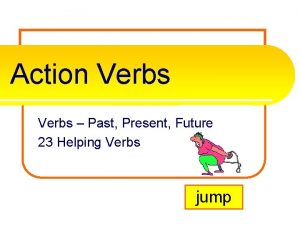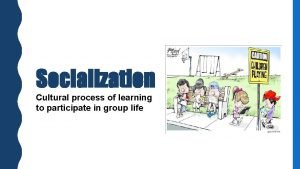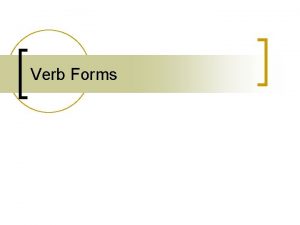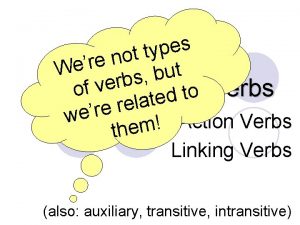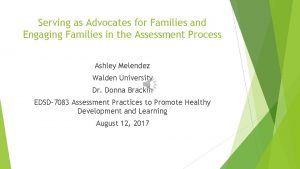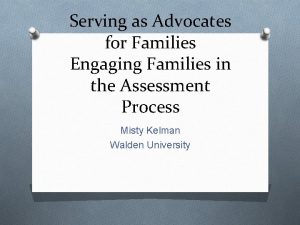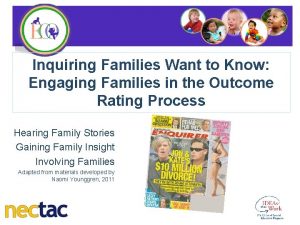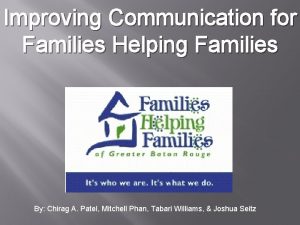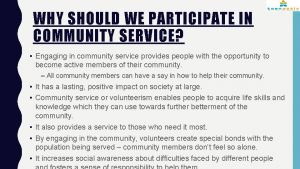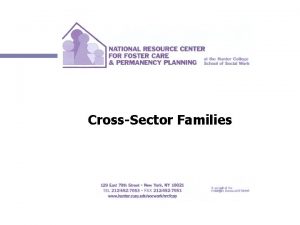ENGAGING FAMILIES WITH DATA HELPING FAMILIES PARTICIPATE IN


















- Slides: 18

ENGAGING FAMILIES WITH DATA: HELPING FAMILIES PARTICIPATE IN CONVERSATIONS ABOUT DATA AT VARIOUS LEVELS WITHIN THE SYSTEM SIOBHAN COLGAN (DASY, IDC) DARLA GUNDLER (DASY, EIFA) JUDY SWETT (ECTA) LISSETTE SAAVEDRA (ECTA) MELISSA RASPA (ECTA)

PURPOSE OF THE SESSION Highlight the importance of family involvement in data discussions at all levels within the system Discuss ways to inform and engage families in conversations about local program and state level data Share and brainstorm strategies for sharing data with families

WHO’S IN THE ROOM TODAY?

STAKEHOLDER ENGAGEMENT OVERVIEW

STAKEHOLDERS AND STAKEHOLDER ENGAGEMENT Who are stakeholders? o o Can be internal or external to an organization/agency Are affected by the outcomes of a project or initiative Provide guidance on the progression of a defined scope of work Examples include: families, ICC members, legislators, others? What is stakeholder engagement? o o Using individual and group participation in a collaborative process that guides the creation and execution of a defined scope of work A recurring and cyclical process

STAKEHOLDER ENGAGEMENT Why involve stakeholders? o o Systems level impact Creative problem solving Satisfaction through collaboration Improved outcomes

EFFECTIVE STAKEHOLDER ENGAGEMENT How to engage stakeholders, in particular families? o o Relevance of information Collaborative partnership Effective communication Shared ownership of problem-solving

PRINCIPLES OF EFFECTIVE STAKEHOLDER ENGAGEMENT Relevance of information o Define and articulate purpose of sharing data with families § Why are we collecting and sharing data? o Specify and define desired outcomes § What outcomes are the program/state hoping to achieve by sharing data with families? Collaborative partnerships o Create partnership with families § How can we work together to achieve desired outcomes?

PRINCIPLES OF EFFECTIVE STAKEHOLDER ENGAGEMENT Effective communication o Establish consistent, responsive methods of communication § When will we communicate with families about data? o Ensuring accessibility of information § How will information be shared with families? Shared ownership o Build family capacity for involvement in discussions about data § How will we help families understand data? § How will we engage families in discussions about data?

DISCUSSION QUESTIONS • How are you currently engaging families in discussions about data? • Are families different than other types of stakeholders? • When/at what levels should you ask for involvement from families? • How do you share information (aka data) back with stakeholders? Is data presented to families differently than for others?

CASE STUDY AND DISCUSSION

SHARING DATA WITH FAMILIES: EXAMPLES AND RESOURCES

SHARING DATA WITH FAMILIES What types of data can be shared with families? o Child and family outcomes data § Program or State Level o General supervision data o Other APR indicator results and compliance data o Tools to help share data § Calculators § Graphics

STATE LEVEL CHILD OUTCOMES DATA Percent of children 100 80 Part C Early Intervention National and State Percentages for Summary Statement 1: Substantially Increased Rate of Growth, 2012 -13 66 63 71 71 67 68 60 40 20 0 Social relationships Note: National data based on 41 states with highest-quality data Knowledge and skills National State Actions to meet needs • Overall, our state data is fairly comparable to the national average for each of the 3 child outcomes.

e St at 4 00 ) , 8 =2 (N og 8 r Pr am og 9 ra m Pr og 15 ra m 1 Pr og 6 r Pr am og 2 ra m 1 Pr og 1 r Pr am og 3 ra Pr m 1 og 2 ra m Pr og 17 ra Pr m 1 og 0 ra Pr m 1 og 8 ra m 1 Pr og 4 ra Pr m 5 og r Pr am og 7 ra m 1 Pr og 9 r Pr am og 1 ra m 1 Pr og 3 ra m 6 Pr m ra m og Pr og ra Pr PROGRAM LEVEL FAMILY OUTCOMES DATA Know their rights 100% 90% 80% 70% 60% 50% 40% 30% 20% 10% 0% • 12 out of the 19 programs in our state are above average on Indicator 1: Knowing your rights

OTHER APR INDICATOR DATA 100% 90% 80% 70% 60% 50% 40% 30% 20% 10% 0% 2008 -2009 -2010 IFSP in timely manner (C 1) 2010 -2011 45 day timeline (C 7) 2011 -2012 -2013 Transition planning (C 8) • For the past 4 years, our state has made slight improvements or maintained high percentages for Indicators C 1, C 7, and C 8.

STATE EXAMPLES North Carolina Early Intervention Program Annual Performance Report FFY 2012

S N O I T N S O E I & S U Q S U C S I D
 List of 23 helping verbs
List of 23 helping verbs Occipito posterior position
Occipito posterior position Dynamisch verbinden
Dynamisch verbinden Marketing involve engaging directly with carefully targeted
Marketing involve engaging directly with carefully targeted Marketing involve engaging directly with carefully targeted
Marketing involve engaging directly with carefully targeted Little families
Little families Resocialization definition
Resocialization definition The cultural process of learning to participate in a group
The cultural process of learning to participate in a group Please follow the below instructions
Please follow the below instructions Thank you for your willingness to
Thank you for your willingness to Everyone must participate
Everyone must participate First sad memory of young jose rizal
First sad memory of young jose rizal Action linking helping verbs
Action linking helping verbs Chad b swim helping verbs
Chad b swim helping verbs Past participle past
Past participle past The 23 helping verbs
The 23 helping verbs Linking verb vs auxiliary verb
Linking verb vs auxiliary verb Poem about modal verbs
Poem about modal verbs Haber in present perfect
Haber in present perfect
